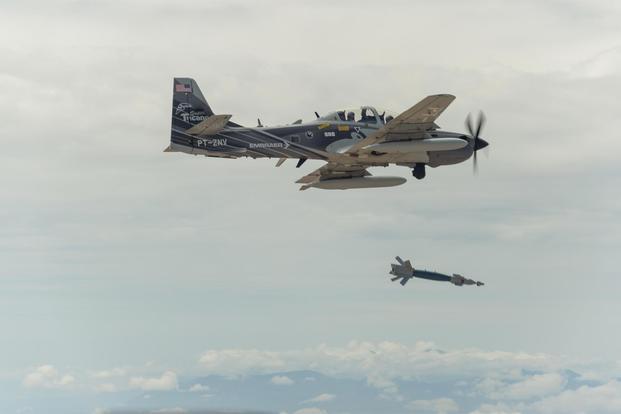The Afghan air force has deployed a GBU-58 Paveway II bomb from an A-29 Super Tucano in combat, marking the first time the Afghan military has dropped a laser-guided weapon against the Taliban.
Equipped with both guided and unguided bombs, an A-29 squadron used the GBU-58 on March 22 to destroy a Taliban compound in Farah, near the Iranian border, according to a U.S. Defense Department release.
"The AAF used the laser-guided technology because of the target's close proximity to civilians," the release said. "The success comes just three months after the AAF completed training to employ a laser-guided bomb. AAF weapons personnel and crew chiefs loaded, armed and launched the aircraft with minimal adviser input," the release said.
Officials said the Afghan pilots who conducted the operation were from Kabul Air Wing's Kandahar A-29 detachment. The AAF also assisted the Afghan National Army in destroying equipment the Taliban had stolen, the release said.
Related content:
- General: US Moving More Airpower to Afghanistan in Strategy Shift
- Afghan Air Force to Get More A-29 Super Tucanos
- A-10s Return to Afghanistan as Air Campaign Heats Up
The light attack aircraft dropped its first laser guided bombs during an exercise in December.
"While U.S. air power is destroying Taliban support elements in the deep fight, Afghan A-29s and MD-530 helicopters provide quick, lethal support to Afghan ground forces in the close fight," said U.S. Air Force Maj. Gen. James Hecker, commander of NATO Air Command-Afghanistan.
"This growth has already started but is going to continue," he told reporters during a televised briefing from Afghanistan last month.
In 2017, the Afghan air force conducted roughly 2,000 airstrike sorties, about 40 a week. The AAF had a record high in October with more than 80 missions in a single week, Hecker said at the time, adding that a few pilots had been trained to drop laser-guided munitions.
The goal for NATO Air Command is to grow the size of the Afghan air force over the next few years, he said.
The U.S. Air Force in December said the Afghans "will more than double their fleet of aircraft over the next seven years" with plans to "include the introduction of AC-208 attack aircraft and UH-60 Black Hawk assault helicopters, along with additional A-29 attack aircraft and MD-530 attack helicopters," according to a news release.
Currently, the AAF has roughly 8,000 troops.
"Right now, the Afghan Air Force has 12 A-29s, but that's going up to 25," Hecker said.
The Defense Department on Tuesday said the goal is to push further, perhaps tripling the AAF in size by 2023.
In April, the AAF will mark the two-year anniversary of the first combat mission by American-trained Afghan pilots flying American-built A-29s, said Greg McCarthy, a public affairs representative for Sierra Nevada Corp. and Embraer.
In October, the U.S. Air Force put in a new order with the two companies to produce six new A-29 Super Tucano aircraft for the Afghan fleet.
-- Oriana Pawlyk can be reached at oriana.pawlyk@military.com. Follow her on Twitter at @Oriana0214.










